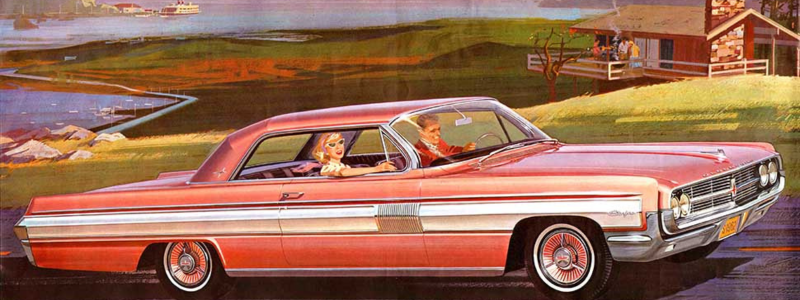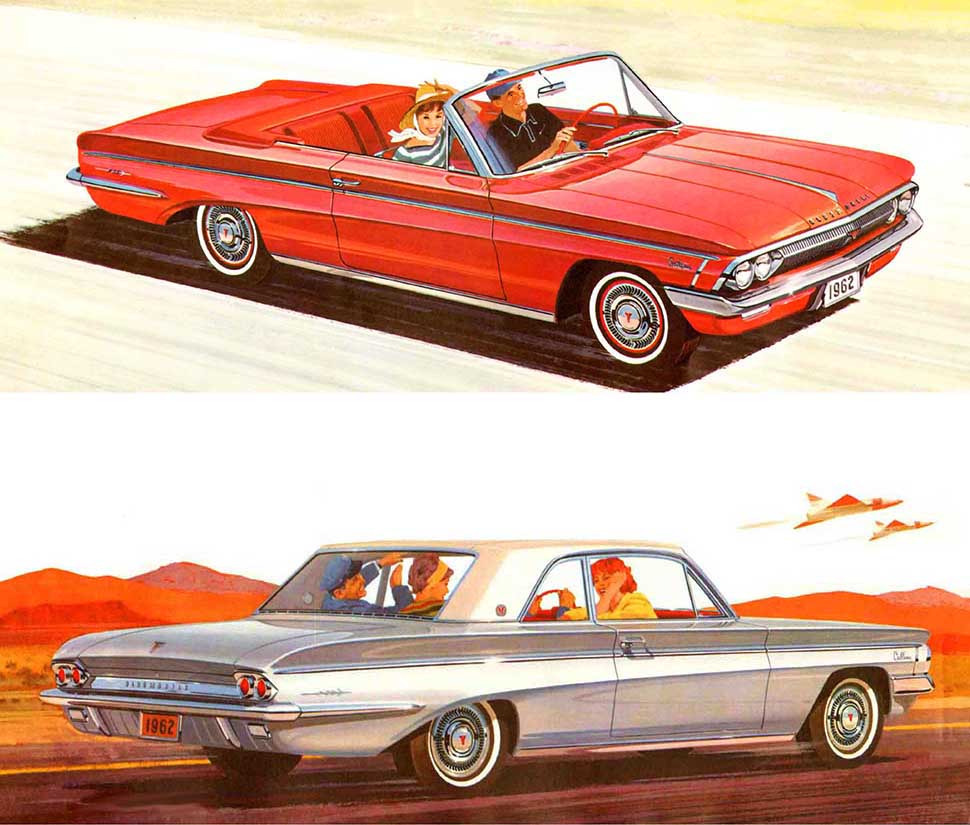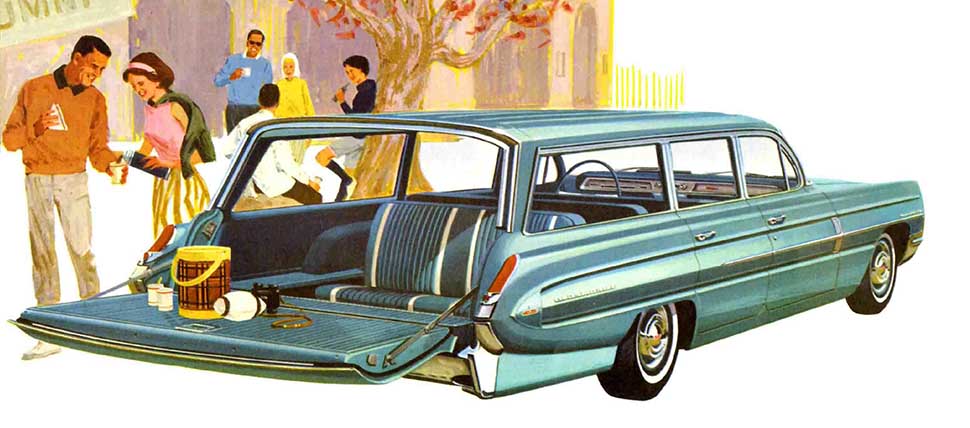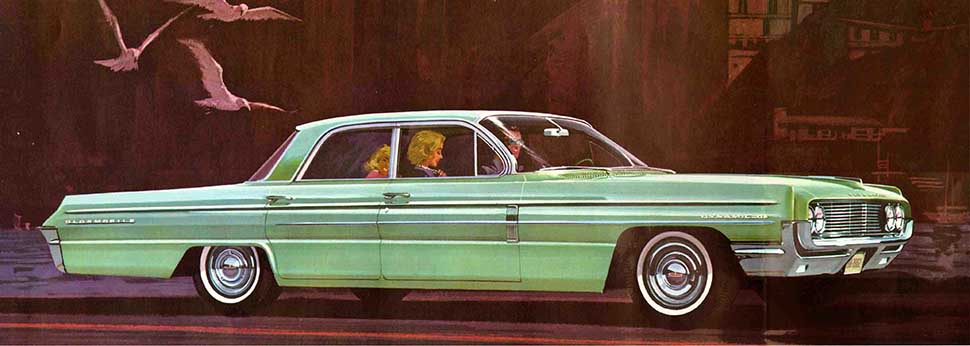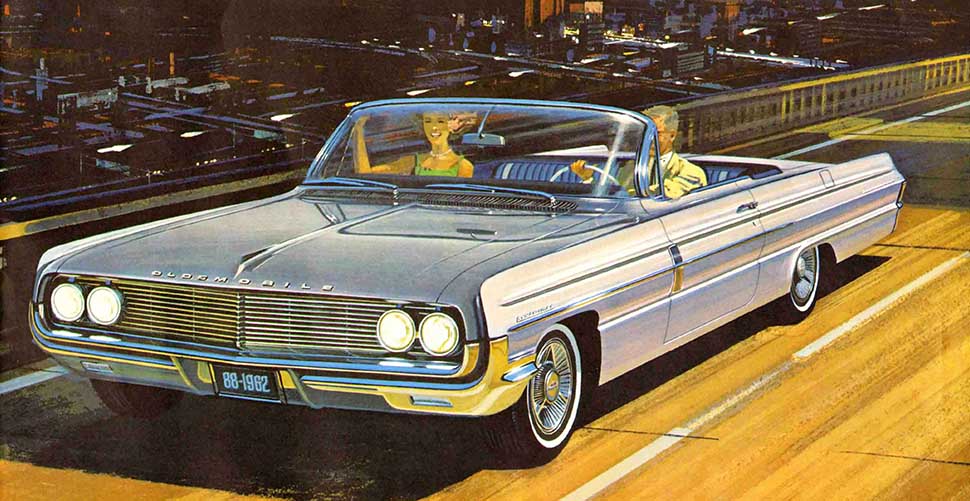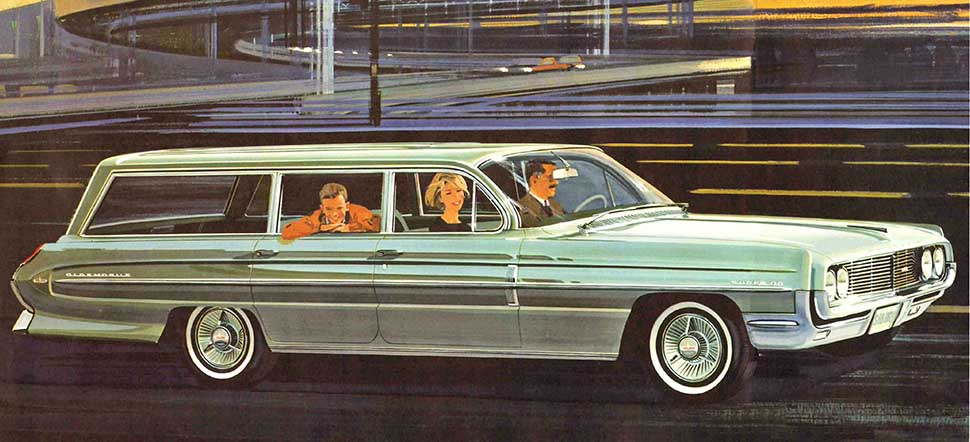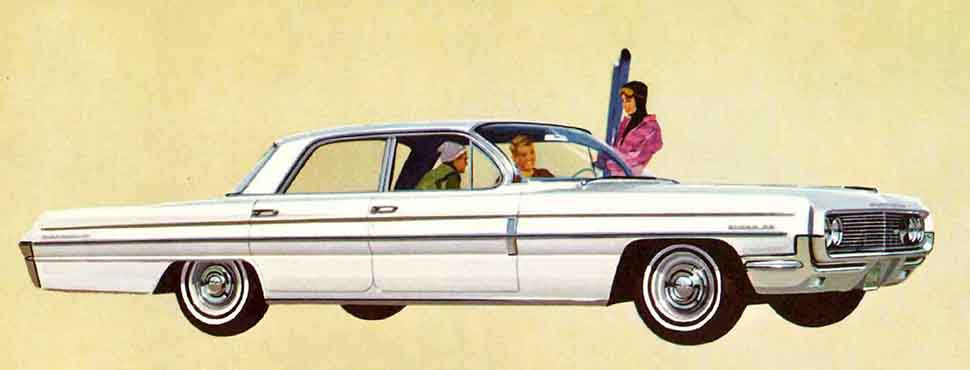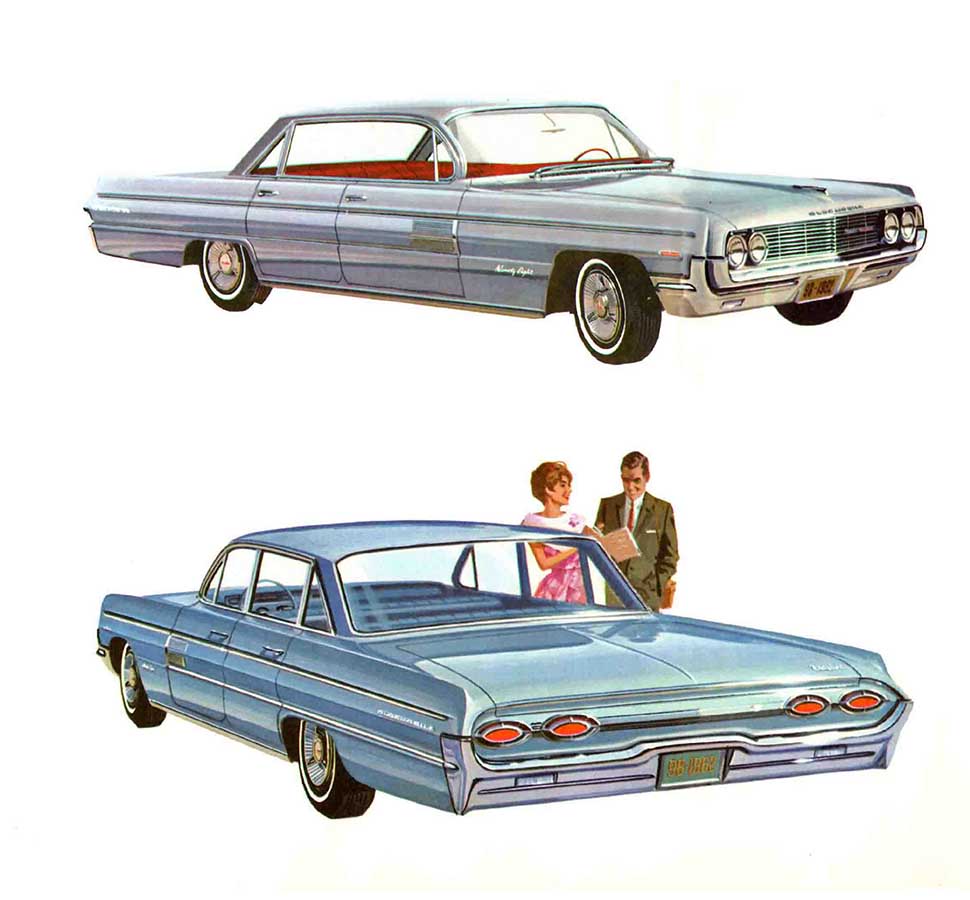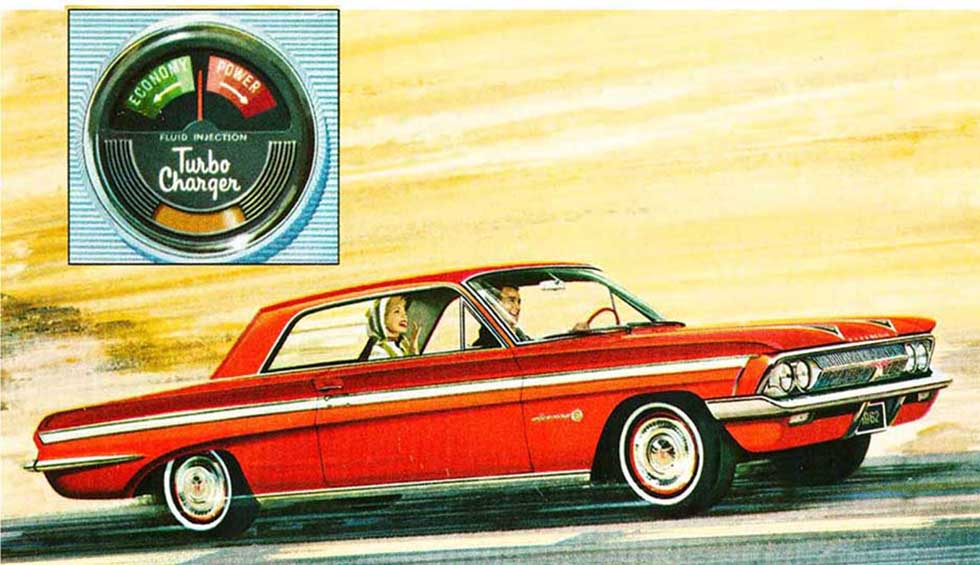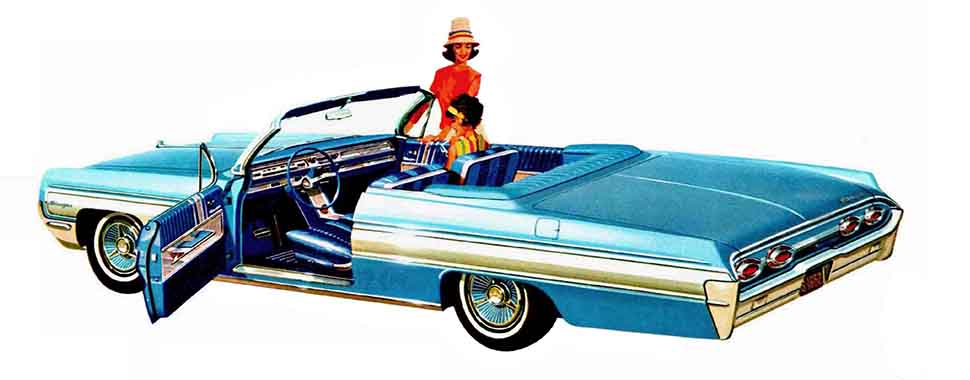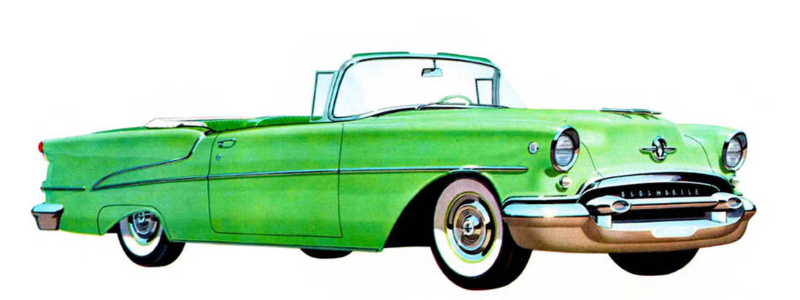General Year Information
The 1962 Oldsmobiles were introduced on September 22, 1961. The turbocharged F-85 Jetfire was announced late in the model year, in April 1962. J. F. Wolfram was the head of the Oldsmobile Division.
The F-85 styling was only slightly tweaked, more so to identify it as a ’62 version. The full-size models were again restyled. Changes included a revised grille and front bumper. At the rear, the fender skegs were removed as GM’s Vice President of Design Bill Mitchell disliked them. Oval taillights, one on each side for Dynamic and Super 88 models, replaced the 1961’s round units. 1962 Starfires and 98s received two oval lights per side.
New rooflines were in place for the four-door Celebrity sedan and Holiday hardtop sedans. All two-door sedans were finally dropped along with the Super 88 Convertible, due to miniscule sales. All two-door hardtops received a new convertible-inspired roofline. The “bubble-top” two-door hardtop was dropped. The length was increased behind the rear wheels about 2 inches to give the ’62 models a longer look. 1962 Dynamic 88 and Super 88 Fiesta wagons were still based on the 88 platform but retained most of the 1961 wagon’s rear styling and overall length.
The standard engine in the Dynamic 88 was uprated to 280 HP due to a higher compression ratio that required the use of premium fuel; however, a regular-fuel 260 HP version was a no-cost option. The Super 88 and Ninety-Eight “Skyrocket” V8 now sported last year’s Starfire 330 HP rating. The Starfire’s V-8 was upgraded to 345 horsepower and was now available on the Super 88 and 98 as an option.
Model year production peaked at 447,594 units, up significantly from 1961’s 317,110, due to the end of the recession and the F-85’s continuing popularity.
Chassis Information
- Wheelbase: F-85 112.0″ 88 and S88 Series 123.0″ 98 Series 126.0“
- Overall length: F-85 188.2″ Starfire, D88 and S88 213.9″ Classic 98 Series 220.0“
- Reartread: F-85 – 56.0″ Full Size – 61.0″.
- Front tread: F-85 – 56.0″ Full Size – 61.0″
- Tires: F-85 6.50 x 13, Super 88 and Dynamic 88 8.00 x 14, Starfire, Classic 98 8.50 x 14
Models Offered
Oldsmobile expanded its small-sized series in 1962 with the F-85 moving into its second year. A Cutlass convertible and hardtop coupe were added along with several DeLuxe versions.
Recognizing that the youth were more performance-oriented, a special turbocharged Jetfire coupe was made available late in the model year. The Garrett turbocharged version of the 215 V8 was rated at 215 HP and 301 ft. lbs. of torque. It was standard with bucket seats, a console with vacuum gauge, and unique trim. Although much faster than a standard F-85, the Jetfire did not receive H.D. suspension nor a tachometer and other tell-tale gauges. Turbocharging the 215’s 10.25:1 engine required a 50/50 mixture of methanol and distilled water to be injected under boost.
Standard F-85 equipment included a heater, defroster, foam cushion seats, and three-speed synchromesh transmission. Upholstery was available in several types of cloth and vinyl.
The 88s were restyled this year with the Dynamic series offering the largest model selection found in the full-size Oldsmobiles. The entire front fascia jutted forward past the fender line, mimicking a huge jet intake. A new grille of thin horizontal bars without any identifiers was set in the opening. The front fender edges jutted ahead of the grille, and the entire fascia was surrounded by a bright metal molding.
On the sides, the previous bright metal strip still ran front to back and still at the beltline. At the front edge of the door, grilles simulating “intakes” ran for about 5 inches horizontally. “Dynamic 88” appeared in the upper front fender just aft of the front edge above the bright trim. “Oldsmobile” in block letters was placed at the back of the rear fender at the beltline.
At the rear, the two oval tail lights were placed at the outer edge of the trunk, and a very thin chrome strip connected them. “88” in the script was placed in the upper right corner of the trunk edge. The rear bumper was now massive and contained the backup lights.
Standard equipment on the series included a padded dash, guard beam frame, live rubber body cushions, coil springs, and foam rubber seats. Interiors were done in a variety of colored fabrics and cloth.
The Super 88 shared its 123-inch wheelbase with the Dynamic 88 and Starfire models and used the same powerplant as the Ninety-Eight series cars. The entire fascia jutted forward past the fender line, mimicking a huge jet intake. A new grille of thin vertical bars with “a stylized “Rocket” logo was placed on the driver’s side. The front fender edges jutted ahead of the grille, and the entire fascia was surrounded by a bright metal molding.
On the sides, the previous bright metal strip still ran front to back and still at the beltline. At the front edge of the door, grilles simulating “intakes” ran for about 5 inches horizontally. “Super 88” appeared in the upper front fender just aft of the front fender edge above the bright trim. “Oldsmobile” in block letters was placed at the back of the rear fender at the beltline.
At the rear, the two oval tail lights were placed at the outer edge of the trunk, and a narrow chrome strip connected them. “Super 88” in the script was placed in the upper right corner of the trunk edge. The rear bumper was now massive and contained the backup lights.
Standard equipment included all items from the Dynamic 88 plus two-speed windshield wipers, parking brake signal lamps, courtesy lamp package, and special moldings. The upholstery selection was from a variety of colored fabrics, types of vinyl and leathers.
A second Starfire model – the two-door hardtop coupe – joined the convertible in 1962. A new grille of thin horizontal bars was split at the midpoint by a horizontal thin bright strip that contained a stylized Starfire logo. The front fender edges jutted ahead of the grille, mimicking a huge jet intake, and the entire fascia was surrounded with a bright metal molding.
On the sides the previous bright metal strip still ran front to back, but now above the beltline just under the door handle. Just underneath, brushed aluminum side trim almost a foot in height ran from front to back. At the front edge of the door, a grille simulating an “intake” and running for about 18 inches horizontally laid over the aluminum trim. “Starfire” in script appeared in the front edge of the brushed aluminum.
At the rear, the four oval tail lights were placed at the outer edge of the trunk, and a wide chrome strip connected them. “Starfire” in script was placed in the upper right corner of the trunk edge. The rear bumper was massive and contained the backup lights.
The Starfire was well-equipped. With standard trim, it included all items standard on the Super 88 plus sports console, tachometer, Hydra-Matic drive with console shifter, power brakes, power steering, brushed aluminum side trim, and dual exhausts with fiberglass-packed mufflers. Leather upholstery was fitted.
The most upscale Oldsmobiles were the Ninety-Eights. A five-model lineup was available with three four-doors and an open and closed two-door. The senior car received some significant styling changes including a new grille of thin vertical bars with “Nighty-Eight” in script on the driver’s side along with a stylized “Rocket” logo. The front fender edges jutted ahead of the grille, and the entire fascia was surrounded by a bright metal molding.
On the sides the previous bright metal strip still ran front to back, but now above the beltline just under the door handle. At the front edge of the door, grilles simulating “intakes” ran for about 1″ horizontally. “Ninety-Eight” appeared in the lower front fender just aft of the wheel well. “Oldsmobile” in block letters was placed at the back of the rear fender at the beltline.
At the rear, the four oval tail lights were placed at the outer edge of the trunk, and a wide chrome strip connected them. “Ninety-Eight” in the script was placed in the upper right corner of the trunk edge. The rear bumper became massive and contained the backup lights.
Cars in this series were well appointed with all equipment from the Super 88 plus HydraMatic transmission, power brakes, power steering, power windows, and power seat. Interiors could be ordered in leather, vinyl, or cloth in a variety of colors.
Engine Options and Availability
- F-85 Base "Rockette" V-8
- Cutlass and Optional F-85 "Rockette" V-8
- Jetfire Turbocharged V-8
- Dynamic 88 Rocket V-8
- Dynamic 88 Econoway Optional Rocket V-8
- Super 88 and 98 and Optional Dynamic 88 "SkyRocket" V-8
- Starfire and Optional S-88 and 98 "Starfire" V-8
Overhead valves. Aluminum Block. Displacement: 215 CID. Bore and stroke: 3.50″ x 2.80. Compression ratio: 8.75:1. Horsepower: 155 @ 4800 RPM. Torque: 210 @ 3200 RPM. Five main bearings. Hydraulic valve lifters. Carburetor: Rochester 2GC two-barrel.
Overhead valves. Aluminum Block. Displacement: 215 CID. Bore and stroke: 3.50″ x 2.80. Compression ratio: 10.25:1. Horsepower: 185 @ 4800 RPM. Torque: 230 @ 3200 RPM. Five main bearings. Hydraulic valve lifters. Carburetor: Rochester 4GC four-barrel.
Overhead valves. Aluminum Block. Displacement: 215 CID. Bore and stroke: 3.50″ x 2.80. Compression ratio: 10.25:1. Horsepower: 215 @ 4800 RPM. Torque: 300 @ 3200 RPM. Five main bearings. Hydraulic valve lifters. Carburetor: Rochester One-barrel, with anti-knock fluid injection.
Overhead valves. Cast Iron Block. Displacement: 394 CID. Bore and stroke: 4.125″ x 3.6875. Compression ratio: 10.25:1. Horsepower: 280 @ 4400 RPM. Torque: 430 @ 2400 RPM. Five main bearings. Hydraulic valve lifters. Carburetor: Rochester 2GC four-barrel.
Overhead valves. Cast Iron Block. Displacement: 394 CID. Bore and stroke: 4.125″ x 3.6875. Compression ratio: 8.75:1. Horsepower: 260 @ 4400 RPM. Torque: 410 @ 2400 RPM. Five main bearings. Hydraulic valve lifters. Carburetor: Rochester 2GC four-barrel.
Overhead valves. Cast Iron Block. Displacement: 394 CID. Bore and stroke: 4.125″ x 3.6875. Compression ratio: 10.25:1. Horsepower: 330 @ 4600 RPM. Torque: 440 @ 2800 RPM. Five main bearings. Hydraulic valve lifters. Carburetor: Rochester 4GC four-barrel.
Overhead valves. Cast Iron Block. Displacement: 394 CID. Bore and stroke: 4.125″ x 3.6875. Compression ratio: 10.50:1. Horsepower: 345 @ 4600 RPM. Torque: 440 @ 3200 RPM. Five main bearings. Hydraulic valve lifters. Carburetor: Rochester 4GC four-barrel.
Power Train Options
- All F-85s were powered by the aluminum block Rockette V-8 engine in either 2-barrel (155HP) or 4-barrel (185HP) form.
- A 215-horsepower turbocharged V-8 was exclusive to the Jetfire.
- A three-standard manual transmission was standard.
- Hydra-Matic was optional on all models.
- The base Dynamic Eighty-Eight motor was a 280-horsepower V-8.
- A 260 horsepower, lower compression ratio V-8 as a no-cost option on the Dynamic 88.
- The standard powerplant on the Super Eighty-Eight and Ninety-Eight was the 330 horsepower V-8 and optional on the Dynamic Eighty-Eight.
- A 345 horsepower V-8 was standard on the Starfire and optional on the Super Eighty-Eight and Ninety-Eight models.
Other Significant Options
-
Significant Options – F-85
- Air conditioning ($378).
- Backup lights ($7).
- DeLuxe radio ($65).
- Electric clock ($16).
- Heater/defroster ($74).
- Outside mirror ($4).
- Padded dash ($12).
- Power steering ($86).
- Windshield washer ($11).
Significant Options – Full-size
- Air conditioning ($435).
- Backup lights ($9).
- Courtesy lamps ($5).
- Electric antenna ($23).
- Electric clock ($19).
- Fiesta luggage carrier ($98).
- Heater/defroster ($97).
- Padded Dash.
- Power brakes ($43).
- Power steering ($107).
- Power windows ($106).
- Radio, DeLuxe ($88)
- Radio, Super DeLuxe signal seeking ($124).
- Rear window defroster ($21).
- Windshield washer ($12).
Body Paint Color Codes
| A Ebony Black | |
| B Heather Mist | |
| C Provincial White | |
| D Sheffield Mist | |
| F Wedgewood Mist | |
| H Currus Blue | |
| J Willow Mist | |
| K Surf Green | |
| L Garnet Mist | |
| M Cameo Cream | |
| N Royal Mist | |
| P Pacific Mist | |
| R Sand Beige | |
| T Sahara Mist | |
| X Sunset Mist |
Click on the Images Below to Enlarge
1962 Oldsmobile Detail Image 1
The 1962 Oldsmobile Starfire line consisted of a coupe and a convertible. The coupe was a popular choice with 34,839 sold.
1962 Oldsmobile Detail Image 18
The 1962 F-85 line was diversified with both DeLuxe and Standard models offered as well as a Convertible and 2- and 3-seat wagons. Not counting the Cutlass and Jetfire models, 48,444 F-85s were sold.
1962 Oldsmobile Detail Image 17
The 1962 Cutlass now came in convertible and hardtop models. with 9,868 of the former and 33,018 of the latter finding buyers.
1962 Oldsmobile Detail Image 16
The 1962 Dynamic 88 Fiesta was a good seller. Offered in 2- and 3-seat configurations, 14,944 were sold.
1962 Oldsmobile Detail Image 15
The 1962 Dynamic 88 4-door Sedan was the most popular Oldsmobile for 1962 with 68,467 delivered.
1962 Oldsmobile Detail Image 14
The 1962 Dynamic 88 2-door Holiday hardtop was quite popular and found 39,676 buyers.
1962 Oldsmobile Detail Image 13
The 1962 Dynamic 88 4-door Holiday hardtop was the second-best seller in the 1962 Olds line with 53,428 produced.
1962 Oldsmobile Detail Image 12
The 1962 Oldsmobile Dynamic 88 convertible was now the only short-wheelbase convertible offered. As a result, 12,212 were produced, a strong number.
1962 Oldsmobile Detail Image 11
The 1962 Oldsmobile Super 88 Fiesta was overshadowed by its Dynamic 88 brother. Only 3,837 made it to buyers.
1962 Oldsmobile Detail Image 10
he 1962 Super 88 4-door sedan was once again the line’s best seller with 24,125 produced.
1962 Oldsmobile Detail Image 9
The 1962 Oldsmobile Super 88 2-door Holiday hardtop saw a respectable 9,010 deliveries.
1962 Oldsmobile Detail Image 7
The 1962 Ninety-Eight Holiday 4-door hardtop and the 4-door Town Sedan were good sellers. The former sold 7,653, and the latter piled up 12,167 in sales.
1962 Oldsmobile Detail Image 6
The 1962 Ninety-Eight 2-door hardtop coupe held its own with 7,546 delivered.
1962 Oldsmobile Detail Image 5
The 1962 Ninety-Eight 4-door Sport Sedan was very popular. Production of 33,095 made it the top selling 98.
1962 Oldsmobile Detail Image 4
The 1962 Ninety-Eight convertible was its usual strong seller with 7,149 produced.
1962 Oldsmobile Detail Image 3
The other new kid on the block was the mid-year-introduced F-85 Jetfire turbo. Given its short run, 3,765 deliveries was a win for Oldsmobile.


